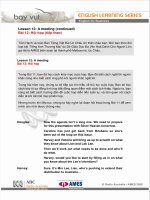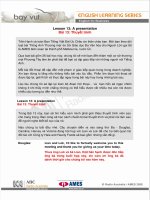Tài liệu Lesson 1: A Simple Welcome Program ppt
Bạn đang xem bản rút gọn của tài liệu. Xem và tải ngay bản đầy đủ của tài liệu tại đây (45.82 KB, 5 trang )
Using Excellent Tools to Write Web Applications Targeting
the .NET Common Language Runtime (CLR)
[Home] [Up] [Lesson01] [Lesson02] [Lesson03] [Lesson04] [Lesson05
[Lesson06] [Lesson07] [Lesson08] [Lesson09] [Lesson10] [Lesson11
[Lesson12] [Lesson13]
On sale Now! C#
Unleashed is an in-
depth guide for
intermediate to
advanced software
developers to learn
the C#
programming
language and
serve as a desktop
reference.
.
.
.
.
.
.
.
.
.
.
The C# Station Tutorial
by Joe Mayo, 8/20/00, updated 9/24/01
Lesson 1: A Simple Welcome Program
This lesson will get you started with C# by introducing a few very simple
programs. Here are the objectives of this lesson:
l
Understand the basic structure of a C# program.
l
Obtain a basic familiarization of what a "Namespace" is.
l
Obtain a basic understanding of what a "Class" is.
l
Learn what a "Main" method does.
l
Learn how to obtain command-line input.
l
Learn about console input/output (I/O).
Listing 1-1. A Simple Welcome Program: Welcome.cs
// Namespace Declaration
using System;
// Program start class
class WelcomeCSS
{
// Main begins program execution.
public static void Main()
{
// Write to console
Console.WriteLine("Welcome to the C# Station Tutorial!");
}
}
The program in Listing 1-1 has 4 primary elements, a namespace
declaration, a class, a "Main" method, and a program statement. It can be
compiled with the following command line:
csc Welcome.cs
This produces a file named Welcome.exe, which can then be executed.
Page 1 of 5Tutorial
6/24/2002 />Other programs can be compiled similarly by substituting their file name
instead of Welcome.cs. For more help about command line options, type
"csc -help". The file name and the class name can be totally different.
The namespace declaration indicates that you are referencing the "System"
namespace. Namespaces contain groups of code that can be called upon
by C# programs. With the "using System;" declaration, you are telling your
program that it can reference the code in the "System" namespace without
pre-pending the word "System" to every reference. I'll discuss this in more
detail in a later lesson, dedicated specifically to namespaces.
The class declaration, "class WelcomeCSS", contains the data and method
definitions that your program uses to execute. It is one of a few different
types of elements your program can use to describe objects, such as
interfaces and structures, which will be discussed in more detail in a later
lesson. This particular class has no data, but it does have one method.
This method defines the behavior of this class (or what it is capable of
doing).
The one method within the WelcomeCSS class tells what this class will do
when executed. The method name, "Main", is reserved for the starting
point of a program. Before the word "Main" is a "static" modifier. The
"static" modifier explains that this method works in this specific class only,
rather than an instance of the class. This is necessary, because when a
program begins, no object instances exist. Classes, objects, and instances
will be covered in more detail in a later lesson. Every method must have a
return type. In this case it is "void", which means that "Main" does not
return a value. Every method also has a parameter list following it's name
with zero or more parameters between parenthesis. For simplicity, we did
not add parameters to "Main". Later in this lesson we'll show what type of
parameter the "Main" method can have.
The "Main" method specifies it's behavior with the "Console.WriteLine(...)"
statement. "Console" is a class in the "System" namespace. "WriteLine
(...)" is a method in the "Console" class. We use the ".", dot, operator to
separate subordinate program elements. It should be interesting to note
that we could also write this statement as "System.Console.WriteLine
(...)". This follows the pattern "namespace.class.method" as a fully
qualified statement. Had we left out the "using System" declaration at the
top of the program, it would have been mandatory for us to use the fully
qualified form "System.Console.WriteLine(...)". This statement is what
causes the string, "Welcome to the C# Station Tutorial!" to print on the
console screen.
Observe that comments are marked with "//". These are single line
comments, meaning that they are valid until the end-of-line. If you wish
to span multiple lines with a comment, begin with "/*" and end with "*/".
Everything in between is part of the comment. You may place a single line
Page 2 of 5Tutorial
6/24/2002 />comment within a multi-line comment. However, you can't put multi-line
comments within a multi-line comment. Comments are not considered
when your program is compiled. They are there to document what your
program does in plain English (or the native language you speak with every
day).
All statements end with a ";", semi-colon. Classes and methods begin with
"{", left curly brace, and end with a "}", right curly brace. Any statements
within and including "{" and "}" define a block. Blocks define scope (or
lifetime and visibility) of program elements, which will be discussed in a
later lesson.
Many programs are written to accept command-line input. Collection of
command-line input occurs in the "Main" method. Listing 1-2 shows a
program which accepts a name from the command line and writes it to the
console.
Listing 1-2. Getting Command-Line Input: NamedWelcome.cs
// Namespace Declaration
using System;
// Program start class
class NamedWelcome
{
// Main begins program execution.
public static void Main(string [] args)
{
// Write to console
Console.WriteLine("Hello, {0}!", args[0]);
Console.WriteLine("Welcome to the C# Station Tutorial!");
}
}
Remember to add your name to the command-line, i.e. "NamedWelcome
Joe". If you don't, your program will crash. I'll show you in a later lesson
how to detect and avoid such error conditions.
In Listing 1-2, you'll notice an entry in the "Main" method's parameter list.
The parameter name is "args". It's what you use to refer to the parameter
later in your program. The "string[]" expression defines the Type of
parameter that "args" is. The "string" Type holds characters. These
characters could form a single word, or multiple words. The "[]", square
brackets denote an Array, which is like a list. Therefore, the Type of the
"args" parameter, is a list of words from the command-line.
You'll also notice an additional "Console.WriteLine(...)" statement within
the "Main" method. The argument list within this statement is different
than before. It has a formatted string with a "{0}" parameter embedded in
it. The first parameter in a formatted string begins at number 0, the
second is 1, and so on. The "{0}" parameter means that the next
Page 3 of 5Tutorial
6/24/2002 />argument following the end quote will determine what goes in that
position. Hold that thought, and now we'll look at the next argument
following the end quote.
This is the "args[0]" argument, which refers to the first string in the "args"
array. The first element of an Array is number 0, the second is number 1,
and so on. For example, if I wrote "NamedWelcome Joe" on the command
line, the value of "args[0]" would be "Joe".
Now we'll get back to the embedded "{0}" parameter in the formatted
string. Since "args[0]" is the first argument, after the formatted string, of
the "Console.WriteLine()" statement, it's value will be placed into the first
embedded parameter of the formatted string. When this command is
executed, the value of "args[0]", which is "Joe" will replace "{0}" in the
formatted string. Upon execution of the command-line with
"NamedWelcome Joe", the output will be as follows:
>Hello, Joe!
>Welcome to the C# Station Tutorial!
Another way to provide input to a program is via the console. Listing 1-3
shows how to obtain interactive input from the user.
Listing 1-3. Getting Interactive Input: InteractiveWelcome.cs
// Namespace Declaration
using System;
// Program start class
class InteractiveWelcome
{
// Main begins program execution.
public static void Main()
{
// Write to console/get input
Console.Write("What is your name?: ");
Console.Write("Hello, {0}! ", Console.ReadLine());
Console.WriteLine("Welcome to the C# Station Tutorial!");
}
}
This time, the "Main" method doesn't have any parameters. However,
there are now three statements and the first two are different from the
third. They are "Console.Write(...)" instead of "Console.WriteLine(...)".
The difference is that the "Console.Write(...)" statement writes to the
console and stops on the same line, but the "Console.WriteLine(...)" goes
to the next line after writing to the console.
The first statement simply writes "What is your name?: " to the console.
The second statement doesn't write anything until it's arguments are
Page 4 of 5Tutorial
6/24/2002 />properly evaluated. The first argument after the formatted string is
"Console.ReadLine()". This causes the program to wait for user input at
the console, followed by a Return or Enter. The return value from this
method replaces the "{0}" parameter of the formatted string and is written
to the console.
The last statement writes to the console as described earlier. Upon
execution of the command-line with "InteractiveWelcome", the output will
be as follows:
>What is your Name? <type your name here>
>Hello, <your name here>! Welcome to the C# Station Tutorial!
By now you know the basic structure of a C# program. You are familiar
with namespaces and classes. You know the "Main" method is your entry
point to start a C# program. You've also learned how to capture
command-line input and perform interactive I/O.
This is just the beginning, the first of many lessons. I invite you back to
take Lesson 2: Expressions, Types, and Variables.
Your feedback is very important and I appreciate any constructive
comments you have. Please feel free to contact me for any questions or
comments you may have about this lesson.
Feedback
C# Station
Copyright (c) 2002 C# Station
Page 5 of 5Tutorial
6/24/2002 />









